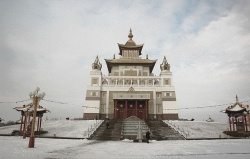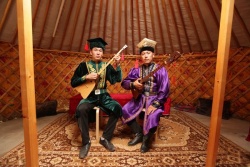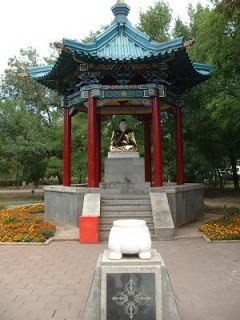An outline of Buddhism advent to the Kalmyks (West-Mongols) by Natalia S. Yakhontova
In the course of many centuries there were different periods, during some of them Buddhism flourished, during other ones it was oppressed. The functioning of it was tightly connected with the historical period and political situation in the territory of their dwelling and in the neighbouring states.
The Kalmyks – West-Mongols – got this name only when they settled to live within the territory of the Russian Empire in the beginning of the 17th century. Before that they were called the Oirats and they lived (actually were moving in search of pastures) on the western territories of modern Mongolia . The Oirats led the nomadic way of life as well as the other Mongolian tribes did. Their language didn’t have any important specific features if compared to Khalkha-Mongolian and they had one common written language with the other Mongolian tribes .
1. The Oirats first acquainted with Buddhism at the same time as the other Mongolian tribes , that is in the 13th century when Chinggis-khan conquered nations which knew Buddhism (Tangut, Uigur, Kidan). Legend has it that there was once a sort of competition between representatives of different religions at the court of Chinggis-khan and a buddhist monk produced some magic, which impressed Chinggis-khan and was approved by him. As a result Buddhism was adopted by the Mongols . Later the first translations of buddhist texts were carried out. These translations were made from Uigur and it was at that period that first sanscrit words entered Mongolian via Uigur . During the next centuries after the collapse of the Mongolian Empire there was a period of political disunity in Mongolia with no active contacts with Tibet . But Tibet was interested in converting Mongolian tribes into Buddhism and its ambassadors visited Mongolian steppers and some Mongols and Oirats reached Tibet .
2. The end of the 16th – beginning of the 17th century is the time when the Manchzhu gained power in China and it was a real threat to Mongolia and there were several attempts made to unite Mongolian tribes . On the other hand Tibetan authorities were very much interested in cooperation with Mongolian khans and expansion of Buddhism . (In 1641 the Vth Dalai Lama asked the future Oirat Gushi-khan for help and got it). This period is often called the second wave of Buddhism in Mongolia .
Here comes the name of Zaya Pandita Namkhai Jamco (1599-1662) - an outstanding Oirat clergyman, scholar and politician. He is highly honoured by the Kalmyks , that’s why several years ago a monument to him was unveiled in Elista – the capital of Kalmykia .
As a young boy he was sent to Tibet to study, successfully finished his education there, worked there but in 1638 he was sent back to his native land by Dalai Lama V and for the next 25 years he travelled along Oirat , Kalmyk and Mongolia n territories trying to establish friendly relations between rulers in that region with Tibet as the religious center.
Zaya-pandita was not only respected clergyman and politician but an outstanding scholar and translator. Due to his efforts Oirat i.e. the West-Mongolian language gained its written form. In the year 1648 he introduced a new “upgraded” version of the old Mongolian script . It got the name “todo bichig” or “clear script” because its aim was to make the written language clear bringing it closer to the colloquial speech.4
Preserving the majority of old Mongolian letters Zaya-pandita eliminated the polysemy of graphical signs, modified writing of some letters, added some diacritical signs and restricted usage for the others. The most evident difference between two scripts was that inter-vocal consonants which were not existent in the Mongolian language even at the time of the Secret History (XII century) were not written in “clear script ”. To sum up, the changes he made were not to reflect specific west-mongolian pronunciation but to make the new script for the whole Mongolian World. Still scholars (at least in Kalmykia and Russia) haven’t reached mutual agreement concerning this point. For historical reasons his script was used only by Oirats and Kalmyks .
Zaya-pandita didn’t use already made Mongolian translations from Tibetan but carried out his own ones from Tibetan into Oirat. The indisputable result of Zaya-pandita’s prolific activities was the translation of a large amount of works: 186 works were translated by him personally and another 36 by his pupils. Many of them were Buddhist Sutras. E.g. one of the first in the list of his translations is the famous Suvarnaprobhasottama sutra ‘The Sutra of Golden Light ’ (in Mongolian Altan Gerel), Prajnaparamita , and many others.
Having been trained in Tibet Zaya-pandita knew the Tibetan language perfectly. Zaya-pandita’s extremely productive work as a translator can be explained by his method of translation which was the most accurate following the original Tibetan text. It can be compared with modern computer translations. The result is that sometimes he broke the grammar rules of his language but translated a lot of works in Oirat using the clear script . His activity provided Oirats and Kamyks with Buddhist teaching in their own language.
3. In the very beginning of the 17th century (1609) a large part of Kalmyks moved to the territory situated by the lower parts of the Volga and Don rivers. They organised Kalmyk khanate which was an independent state but they needed an official recognition from Russia and in 1661 taisha Monchak (the son of Shukur-Daichin who brought Oirats to Volga region ) swore his loyalty to the Russian Tzar . The Kalmyks communicated with Tibet constantly. They sent boys to study there. The head of the Church in Kalmyk khanate was appointed by Dalai Lama . Their Khan was blessed by Dalai Lama and confirmed by the Russian Tzar. The policy of Russia was aimed to subdue Kalmyks and turn them away from Tibet. One means was their baptizing. Those who baptized gained benefits in different ways, so it was often a formality.
4. In 1771 during the reign of Catherine the Great a major part of Kalmyks moved back to Junggaria and those who stayed were less in number. It was a pretext to abolish the Kalmyk khanate and to put more control over the Kalmyks . So step by step Russia succeeded in subduing them. Still the 19th century was the period when there were no persecution of Buddhism especially in comparison to what was to come. Many khuruls (temples) were built at that time some of them were permanent not moving. By the end of the 19th century there were about 70 big and small khuruls (temples). One cannot help mentioning Hosheutovskii khurul built in honour of the victory over Napoleon - the only one, the remnants of which survived till nowadays). By the way they are planning to finish the restoration works there before 2009 – the year when the 400th anniversary of Kalmyks ’ joining Russia is going to be celebrated.
The highest post in Kalmykia was “Lama of all Kalmyks ” who was not elected but appointed by Astrahanskii and Stavropolskii governors and then their appointment was confirmed by the Minister of Foreign affairs and the Tzar . Lama was one of the officials in the system of administration in Russia since he received his salary from the state.
Baptizing of Kalmyks was especially active in the second half of the 19 th century.
5. Some positive changes took place in 1905 after the first Russian revolution . On 17 April 1905 a Royal Order on religious toleration was issued. Its paragraph 16 forbade to use words “pagans ” and “idolater ” speaking about buddhists (lamaists ). The well-known Royal Manifesto (17 October) declared (among other freedoms) religious freedom which trigged further development of Buddhism . During the next ten years number of khuruls (temples) increased up to 26 big and 53 small (in 1914) and the number of lamas rose more than twice. In 1908 – two higher schools “canit-choori” were allowed to be opened in Maloderbet and Ikicuhorovskii ulus Astrahanskaya province. One more was opened in 1910. The program of education was organised according to the Tibetan pattern and teaching was carried out in Tibetan. The school in Maloderbet was housed in a building donated by Ceren David Tundutov, the money was given by Agvan Dordgiev himself, and wealthy Kalmyks , Dordgiev provided a lot of necessary utensils and books. He was the director of this school till 1917 and after him it was headed for about a year by Badma Bovayev who was lucky to die in an accident.
6. The revolution of 1917 and revolutionary terror employed by the Government led to extermination of all and everything. In spite of harsh measures of the 1920ties, however, there still were 42 khuruls and about a thousand and a half clergymen in 1929. The mass repressions came in 1929. They were applied not only to the Buddhist population and clergy but to the Russian ortodox church as well. Alongside with thousands of thousands of ordinary people of the country. It goes without saying that no temples, no Buddhist schools, no lamas existed in Kalmykia by the beginning of World War II. The last Lama of all Kalmyks – L.Tepkin (appointed in 1925) was executed in 1931.
7. In winter 1943-1944 the Kalmyks were exiled to Siberia . Nothing to add. After their rehabilitation and return there were no Buddhist activity in Kamykia till 1988. Now there are more than ten khuruls in Kalmykia. Two in the capital: Sakiusn sume (1995) and Gedun Shaddub Choihorling (2005).
Source
Author: Natalia S. Yakhontova
budcon.com



